Table of Contents
Bridging the Transition: Labour Mobility and Workforce Adaptation in Canada’s Just Transition is a research project delivered through the University of Ottawa Graduate School of Public and International Affairs’ Directed Research Placement program.
About the Author

Ayaka Naganuma (she/her/elle) is the author of this report for the Broadbent Institute through the University of Ottawa’s Graduate School of Public and International Affairs’ Directed Research Placement program. She has experience in local government in Japan, regional revitalization, and UN communications. Her research focuses on climate adaptation, disaster resilience, migration, and social infrastructure development, working with various institutions. She is passionate about policy analysis and the intersection of climate policy and economic growth.
Report Presentation by Ayaka Naganuma at the 2025 Progress Summit
Executive Summary
As Canada moves toward its 2050 net-zero emissions goal, high-emission sectors such as coal, oil, and gas are undergoing a challenging structural transition. With the growing global emphasis on climate action, a Just Transition is not merely a domestic labour market issue but an integral part of a broader effort to build a sustainable economy and society. However, the policy landscape remains uncertain. Fluctuations in energy markets, shifts in international climate policies, and evolving political and economic conditions at home and abroad all add layers of complexity to the transition process. In this context, ensuring employment stability and workforce mobility requires a flexible and comprehensive policy approach. Yet, current policies often fail to fully reflect the realities faced by workers, with barriers such as high specialization, strong local ties, and wage disparities limiting labour mobility–that is, the ability for workers to move geographically for jobs.
This report examines labour mobility within Canada’s high-emission sectors using economic data and statistical methodologies—including correlation analysis, principal component analysis (PCA)—to assess the effectiveness of current policies and identify areas for improvement. The findings indicate that short-term labour mobility remains limited, while long-term transitions are often driven by external economic pressures rather than proactive support measures. Wage levels, skill transferability, and regional economic stability emerge as key determinants influencing mobility.
To address these challenges, this report puts forward three key policy recommendations:
- Managing the economic shocks of transition
Introducing long-term wage insurance, strengthening pension support, and expanding inclusive assistance for non-standard and vulnerable workers. - Designing sustainable career transitions
Establishing an integrated cross-sector training system, implementing a skills passport, and tailoring workforce training based on regional and occupational similarities. - Building the next-generation employment ecosystem
Implementing targeted tax incentives and investment policies beyond the renewable energy sector, strengthening labour unions and industry collaboration, and fostering economic diversification and job creation at the regional level.
A “just transition” requires a coordinated effort between governments, industries, workers, and communities. This report provides a data-driven roadmap for refining existing policies, ensuring labour market stability, and supporting the long-term resilience of regional economies.
1. Introduction
The Necessity of Labour Mobility and a Just Transition in Canada’s High-Emission Sectors
As Canada strives to achieve net-zero greenhouse gas emissions by 2050, high-emission sectors—particularly coal, oil, and gas—are compelled to undergo significant structural transformations. Strengthened climate policies, fluctuations in international energy markets, and a global shift toward clean energy will inevitably influence a decline in demand for these traditional industries. Even under the most conservative scenarios, Canadian oil production is projected to decrease by over 20%, and natural gas production by approximately 37%, posing the serious risk of job losses and regional economic disruption in provinces and regions heavily dependent on fossil fuels (Canadian Climate Institute, 2024).
In this context, ensuring a “just transition” that enables affected workers to seamlessly move into emerging industries is critical for mitigating economic disparities and fostering sustainable regional development. In theory, shifting workers from declining industries to low-carbon sectors developed for growth should reduce unemployment and address skills mismatches. In practice, however, high levels of specialization and deep-rooted community ties make such mobility challenging. When low-carbon sectors are based in regions and provinces away from the communities that high-emissions industries are based, this presents another layer of challenges for decarbonization across the economy. Wage disparities, relocation costs, and strong familial and local community bonds further restrict labour mobility.
Moreover, traditional policy approaches have tended to be top-down–typically uninformed by the affected workers without substantial engagement with labour unions. Although government, corporate, and international agencies have implemented retraining programs and economic support measures, these initiatives often fail to fully reflect the realities and needs of workers and local communities. For example, Pai et al. (2020) identified 17 key elements essential for a just transition in their systematic review, emphasizing the importance of community engagement and consideration of workers’ individual backgrounds. In the global examples of transformation of the coal industry, long standing local attachments and deep interpersonal relationships further exacerbate the challenges of labour mobility for both policymakers and workers. (Carley et al., 2018; Beatty & Fothergill, 1996; Danson, 2005; Fothergill, 2001)
This paper employs various economic datasets—including the Interprovincial Labour Mobility data released by Statistics Canada—and applies Python-driven correlation analyses, principal component analysis (PCA), and p-value testing to examine the dynamics and determinants of labour mobility in high-emission sectors, in particular extractive natural resource industrial sectors. Our goal is to clarify the shortcomings of current policies and the practical challenges workers face, thereby providing empirical insights that can inform the design of future retraining programs and strategies for regional economic diversification.
The benefits of enhanced labour mobility extend beyond mere job creation, offering broader advantages such as improved skill development and the reduction of regional economic disparities. However, promoting labour mobility requires not only the provision of opportunities but also the establishment of environments that allow workers to adapt to new roles while maintaining adequate wages and benefits. To that end, this paper quantitatively assesses occupational similarities based on economic and employment data, identifying which occupations are viable pathways for transition and demonstrating patterns in interregional labour mobility. In summary, this report aims to provide a multi-faceted analysis of labour mobility challenges and the imperative for a just transition in Canada’s high-emission sectors. By integrating both top-down policy perspectives and bottom-up community insights, this research seeks to re-evaluate the current situation and lay the groundwork for policies that leave no one behind. The following sections will further discuss current policy challenges and propose actionable improvements based on our analysis.
2. Just Transition and Canada’s Current Challenges
Labour Mobility Trends and Transition Policies in Canada’s High-Emission Sectors
Canada’s labour market exhibits distinct dynamics across regions and industries, with labour mobility particularly stagnant in high-emission sectors. This analysis using Python-driven correlation techniques on datasets—including those from Statistics Canada—reveals that workers in the coal, oil, and gas industries demonstrate significantly lower mobility compared to those in growing sectors. This phenomenon is largely attributed to the high level of specialized skills required and the strong bonds workers have with their local communities.
Overview and Challenges of Existing Transition Policies
In pursuit of long-term zero-emission goals, the Government of Canada has implemented a range of measures targeting high-emission sectors, such as transition policies for the coal industry. These measures include retraining programs for coal workers, employment support initiatives, and investment strategies aimed at diversifying regional economies. However, current policies tend to adopt a “reactive” approach—relying heavily on unemployment benefits and temporary support measures—which has drawn criticism for not addressing social inequities. (Hadrian Mertins-Kirkwood & Deshpande, 2019) In contrast, some experts advocate for a more “proactive” approach that emphasizes the creation of high-quality jobs in the clean energy sector and prioritizes local employment to address these gaps and inequities among workers.
Academic research further suggests that a transition to clean energy does not automatically guarantee the maintenance of traditional wage levels or employment conditions. New jobs may carry the risk of short-term instability or lower wages. (Cha, 2016, 2017; Healy & Barry, 2017; Newell & Mulvaney, 2013) While the shift to renewable energy may offer temporary job creation, concerns remain regarding the long-term stability and career progression for workers. Evidence from former industrial regions in the UK, for example, indicate that post-industrial job transitions often leave workers trapped in part-time or low-wage positions, which lend to a lower quality of life than what was provided from the previous industries and major criticisms of these policies from the workers facing the declining quality of employment. (Minchin, 2009; Danson, 2005)
Furthermore, recent geopolitical tensions as well as global and domestic economic shocks introduce additional uncertainties. These dynamics could lead to unpredictable fluctuations in environmental policies and investments in renewable energy. For instance the retrenchment of support for market-based carbon pricing mechanisms by its former proponents in the federal government responding to inflationary pressures lends lessons to applicability of any climate policy shift in Canada. Without accounting for these variables, such as trade wars with the United States, supply shocks caused by conflicts abroad, and supply shocks induced by climate change, policies to develop the long-term shift to clean energy may be undermined.
Analyzing Labour Mobility and Strengthening Policy Strategies
This report provides an in-depth analysis of interprovincial labour mobility and the correlation between industrial and occupational data in Canada’s high-emission sectors. Specifically, the use of PCA enables quantitative analysis of the similarities between occupations and identifies those jobs that could serve as effective bridges to industries with lower emissions and closely related occupational characteristics. Additionally, by examining the relationships between various economic indicators, this analysis highlights opportunities for retraining and proposes potential improvements in labour market policies.
The Canadian Buildings and Trade Unions report “Building Canada’s Net‑Zero Future: A Just Transition for Energy Workers,” (2022) and research by Mertins-Kirkwood and Deshpande, have emphasized direct transitions from fossil fuel industries to clean energy sectors. However, recent research indicates these transitions are not as straightforward as expected, often demonstrating significant barriers such as geographic and structural barriers, limited transferability of skills due to narrow skill in high-carbon industries, and regional imbalances in employment opportunities, all of which hinder practical labour transitions. (Lim, Aklin & Frank, 2023; Xie et al., 2023; Zaussinger, Schmidt & Egli, 2025) Recognizing these limitations, this study instead focuses on transitions from high emissions extractive jobs to jobs in closely related industries, with similar occupational characteristics and regional proximity, thereby offering more realistic and feasible policy options. Taken together, these findings suggest that a comprehensive understanding of labour mobility and employment patterns in high-emission sectors is essential—not only for generating new jobs but also to develop public policy for stabilizing workers’ livelihoods, revitalizing regional economies, and addressing climate change. The results of this analysis demonstrate the limitations of current transition policies and offer valuable insights for designing more effective measures. Ultimately, the successful implementation of a just transition hinges on integrating top-down policy initiatives with the practical needs of local communities, ensuring that no one is left behind.
3. Research Methods and Data Analysis
This study leverages open data from Statistics Canada—particularly the Interprovincial Labour Mobility dataset—to quantitatively examine labour mobility trends and their underlying determinants across various industries. This study employs correlation analysis, principal component analysis (PCA), and p-value testing using Python to identify statistically significant relationships and similarities between occupational groups.Special emphasis is placed on the North American Industry Classification System (NAICS) definition for the “Mining – Oil & Gas” sector, focusing on Statistics Canada’s National Occupation Classification (NOC) codes for occupations 822 (contractors and supervisors in mining, oil, and gas), 823 (underground miners, oil and gas drillers, and related occupations), and 841 (mine service workers and operators in oil and gas drilling), while also comparing these findings with other industry groups (Mining & Forestry, Natural Resources & Fishing, Construction, Logistics & Transportation, Machining & Metalworking, and Manufacturing).
Initially, for each industry and occupation, interprovincial labour mobility rates are designated—measured at both one-year and five-year intervals as the dependent variables (Y). Independent variables (X) included a broad array of economic and demographic indicators such as gender ratio, age distribution, educational attainment, employment status, wage levels, regional GDP, unemployment rates, and job vacancy rates. Through correlation analysis, the strength and direction of relationships between labour mobility and these factors are quantified, thereby isolating the key determinants influencing worker mobility. This analysis confirmed significant differences in labour market characteristics between the “Mining – Oil & Gas” sector and other industry groups.
Subsequently, a PCA was conducted to condense the complex, multivariate labour market data into a few principal axes. This reduction enabled the visual capture of the similarities and differences between occupations, clarifying the extent to which occupations within “Mining – Oil & Gas” share common characteristics with those in other sectors. The outcomes of the PCA provide a robust foundation for developing targeted retraining programs and career pathways, as they highlight strategic clusters of occupational similarity.
Furthermore, p-value testing to the results of the PCA was applied to assess the statistical significance of the observed labour market features and inter-occupational similarities. Specifically, a p-value below 0.05 indicates that the differences and relationships identified along each principal axis are unlikely due to chance and indeed contribute meaningfully to the characteristics of labour mobility. This step reinforces the validity of the PCA findings, thereby bolstering the empirical evidence that underpins the policy recommendations that follow. In summary, this study aims to delineate the characteristics and trends of labour mobility within Canada’s high-emission sectors—particularly in the “Mining – Oil & Gas” sector—demonstrated by correlation analysis to understand mobility patterns, and by employing occupational similarity analysis to demonstrate potential career transitions within the sector. The insights derived from these analytical methods offer concrete recommendations for enhancing current labour market policies and retraining programs, ultimately contributing to the formulation of practical strategies that facilitate inter-industry transitions.
4. Results of Quantitative Analysis
This quantitative analysis is based on Statistics Canada’s Interprovincial Labour Mobility data is demonstrated through descriptive statistics, correlation analysis, principal component analysis (PCA), and p-value testing. In particular, data on workers in the extractive “Mining – Oil & Gas” sector is analyzed to compare with other industry groups to elucidate the actual state of labour mobility and its underlying factors.
Descriptive Overview
Interprovincial Labour Mobility refers to the movement of workers from one province to another within a country in search of employment. Descriptive statistics from the Interprovincial Labour Mobility data, as of 2021, present the proportion of workers today who lived in a different province one year ago and five years ago. Overall, short-term mobility rates have remained relatively stable, while longer-term mobility rates exhibit significant variability across regions and industries. In addition, there is a lower likelihood of interprovincial labour mobility in natural resource sectors than in other industrial sectors which suggests that workers in these sectors are less likely to relocate between provinces.
Within the Mining – Oil & Gas sector in particular, despite the influence of high specialization and regionally anchored employment environments, short-term mobility is lower compared to other sectors. This pattern suggests that while high specialization and local ties act as barriers to short-term mobility, over the long run these barriers gradually diminish, or exogenous factors (such as regional industry decline) come into play, thereby promoting labour mobility, albeit at a slower pace. This trend is also suggested in provincial-level data, where long-term labour mobility may be stimulated by the decline of local industries in regions with fragile economies or smaller economic spheres.
Figure 1–Average Labour Mobility Rate by Occupation Group (1 Year vs 5 Year)
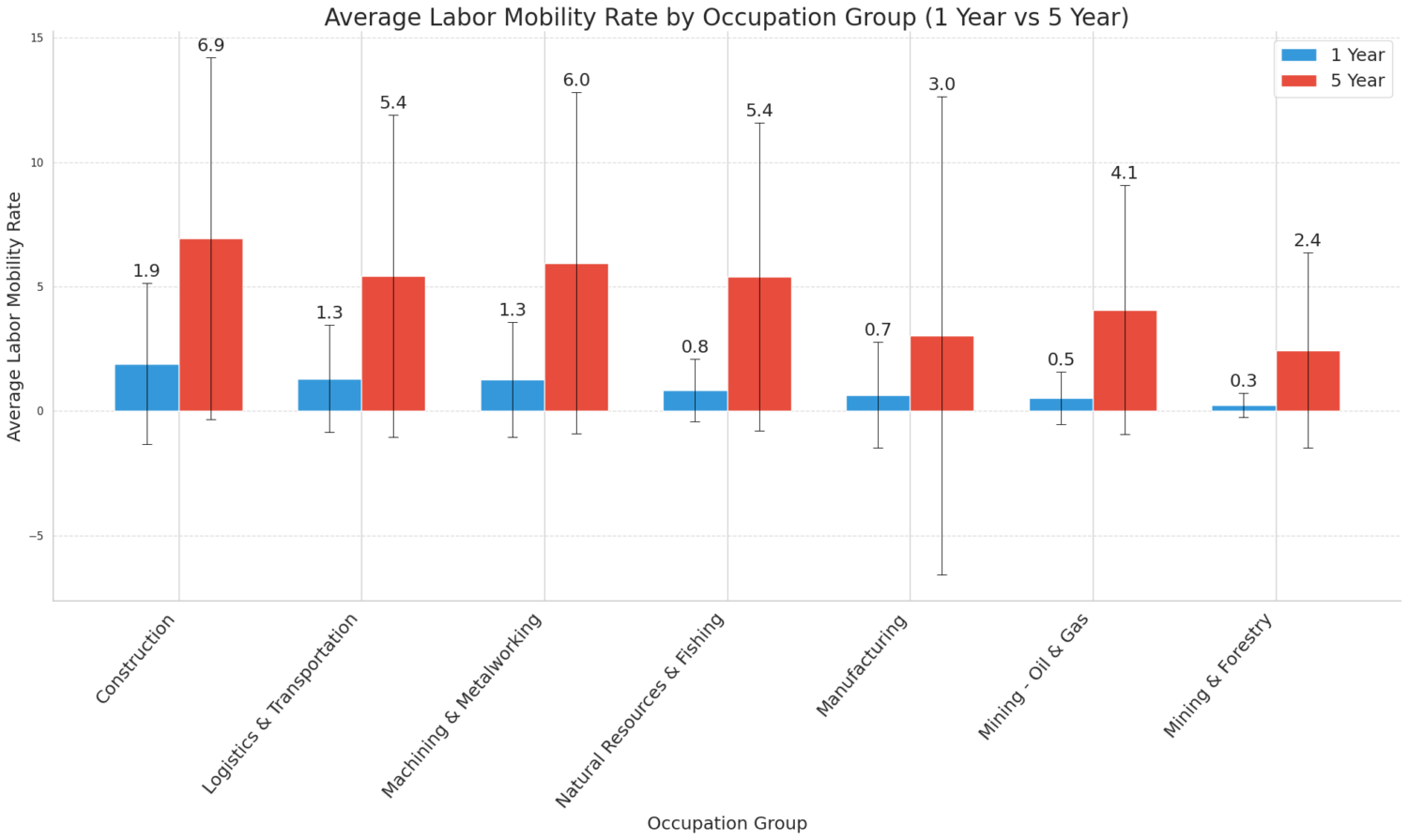
Figure 2 – Average Labour Mobility Rate in the Mining – Oil & Gas Sector by Province (1 Year vs 5 Year)
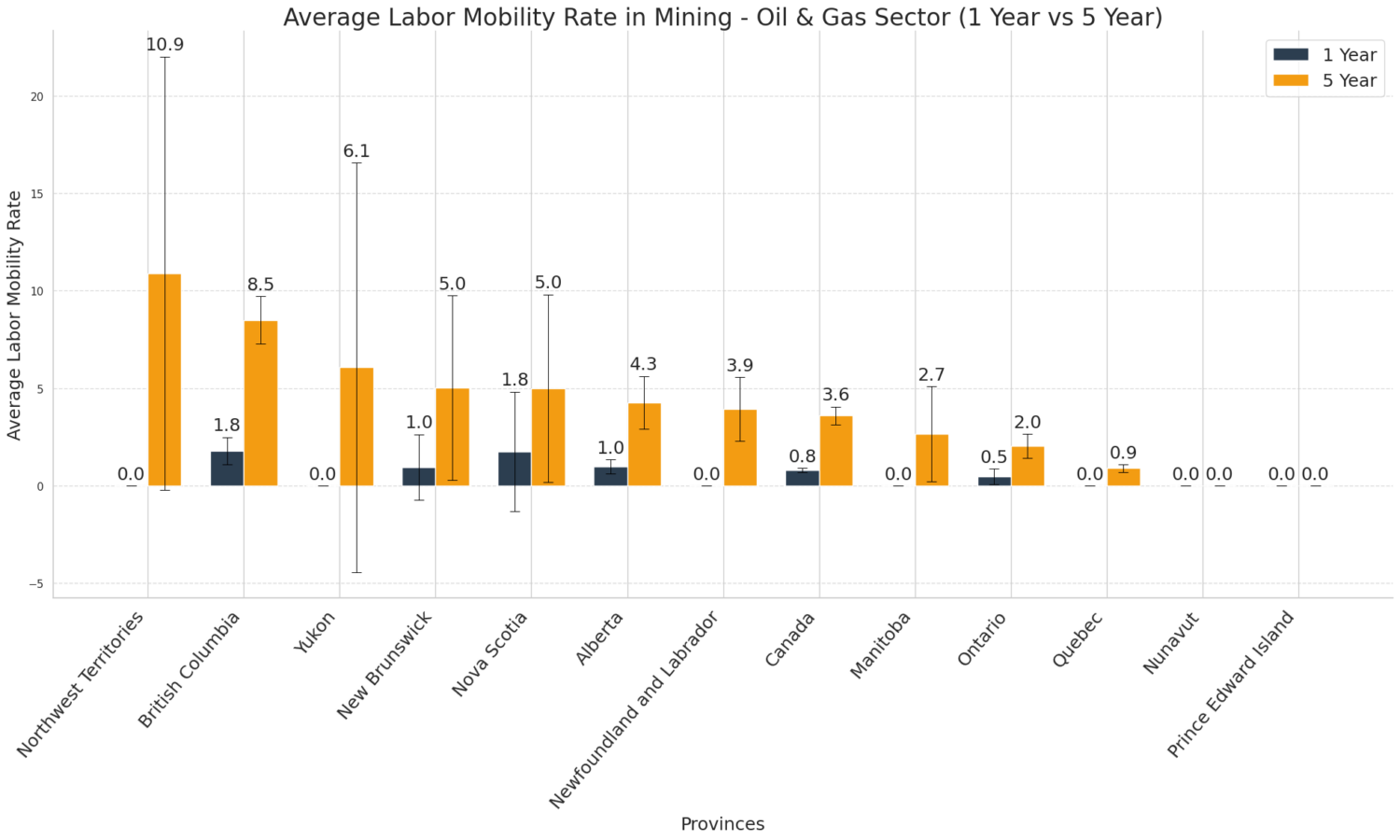
Correlation Analysis and Interpretation
Correlation analysis demonstrates the relationships between both short-term (1-year) and long-term (5-year) labour mobility in the Mining – Oil & Gas sector and various influencing factors. For short-term mobility, relatively positive correlations were found with factors such as the proportion of young workers (15–24 years) and older workers (55–64 years), education levels at high school or early college, job vacancy rates, regional average hourly wages, as well as differences across provinces and union membership rates. Conversely, certain occupational categories and the degree of specialization act as barriers, negatively correlating with mobility. However, the overall correlation was weak.
Regarding long-term mobility, a lower rate of mobility was observed among workers aged 25–54 and those with vocational or technical certifications, while higher mobility was medium-strong correlated with workers aged 55–64, occupations with higher average wages, regions with elevated job vacancy rates, higher median employment income, provincial factors, and the influence of unionization rates. These results demonstrate that educational attainment, wage levels, and particularly unionization rates are associated with labour mobility, suggesting that these factors may have a certain impact on labour market fluidity. On the other hand, negative correlations were observed between both short-term and long-term mobility and specific occupational categories, indicating that these occupations may act as factors that hinder labour market fluidity.
Figure 3 – Correlation Heatmap of 1 Year Labour Mobility and Economic Variables
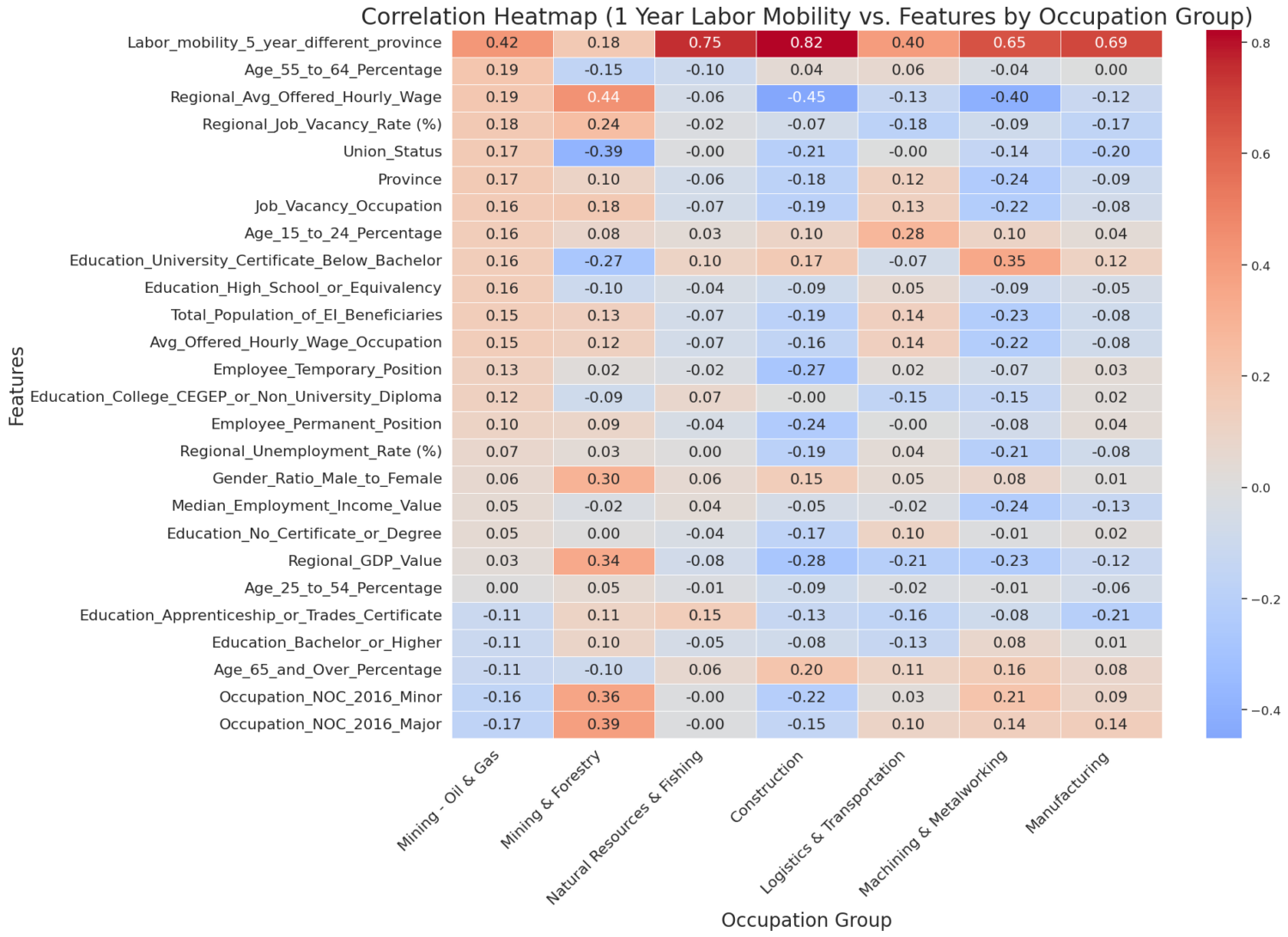
Figure 4 – Correlation Heatmap of 5 Year Labour Mobility and Economic Variables
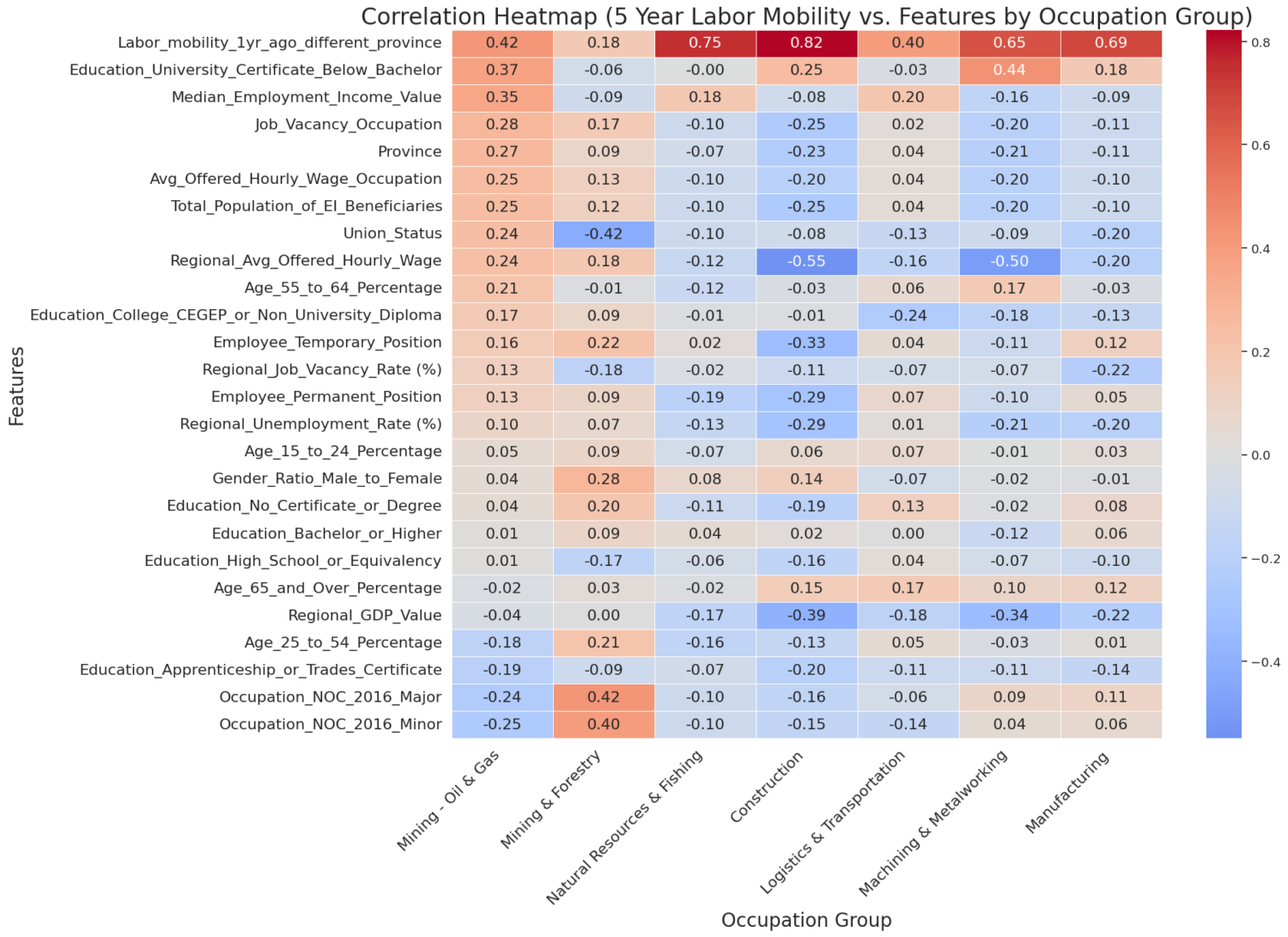
PCA and p-value Testing Results
To evaluate the extent to which occupations in the Mining – Oil & Gas sector (NOC Codes 822, 823, 841) resemble those in other industries in terms of structural and economic characteristics and labour mobility, a principal component analysis (PCA) was employed to condense complex labour market data into two principal dimensions, providing a quantitative measure of similarity that can be compared. The first principal component analysis (PCA1) reflects employment structure, social security, and educational levels, to determine the effects of these socioeconomic characteristics while the second (PCA2) captures labour market fluidity and regional economic factors to study the effects of these economic settings.
P-value testing was then applied to determine whether the differences observed on the principal components analyses were statistically significant. In the comparison between Mining – Oil & Gas and occupations in the Logistics & Transportation sector, a significant difference was observed on PCA1 (t = 3.935, p = 0.006), suggesting that differences in labour practices, job stability, and market fluidity necessitate retraining and adaptation during career transitions. Although no significant difference was detected on PCA1 between jobs in Mining – Oil & Gas and jobs in the Manufacturing industrial sector, a significant difference was found on PCA2 (t = 3.011, p = 0.013), indicating substantial differences in salary levels and other economic factors that may require economic adjustments during such transitions.
As a result, this analysis demonstrated a high degree of similarity among jobs in the Manufacturing, Mining & Forestry, and Natural Resources & Fishing sectors (Figure 5). Moreover, when quantifying the proximity between occupations based on PCA loadings and p-value test results, it was found that the three occupations exhibit a particularly high similarity with other Manufacturing occupations (Figure 6). From a TEER perspective, which categorizes jobs based on training, education, experience, and responsibilities, the five occupations most similar to those in the Mining – Oil & Gas sector tend to show high similarity from high TEER values (indicating greater specialization and responsibility) to low TEER values, suggesting that a decline in job quality and salary levels may be a concern during career transitions.
TEER, introduced by Statistics Canada in the 2021 version of the National Occupational Classification (NOC), categorizes occupations by the required level of education, training, work experience, and responsibilities. The system ranges from TEER 0 (highest level) to TEER 5 (lowest level), aligning jobs with appropriate skill levels and qualifications.
Figure 5 – Principal Component Analysis of Occupational Similarities Across Industries
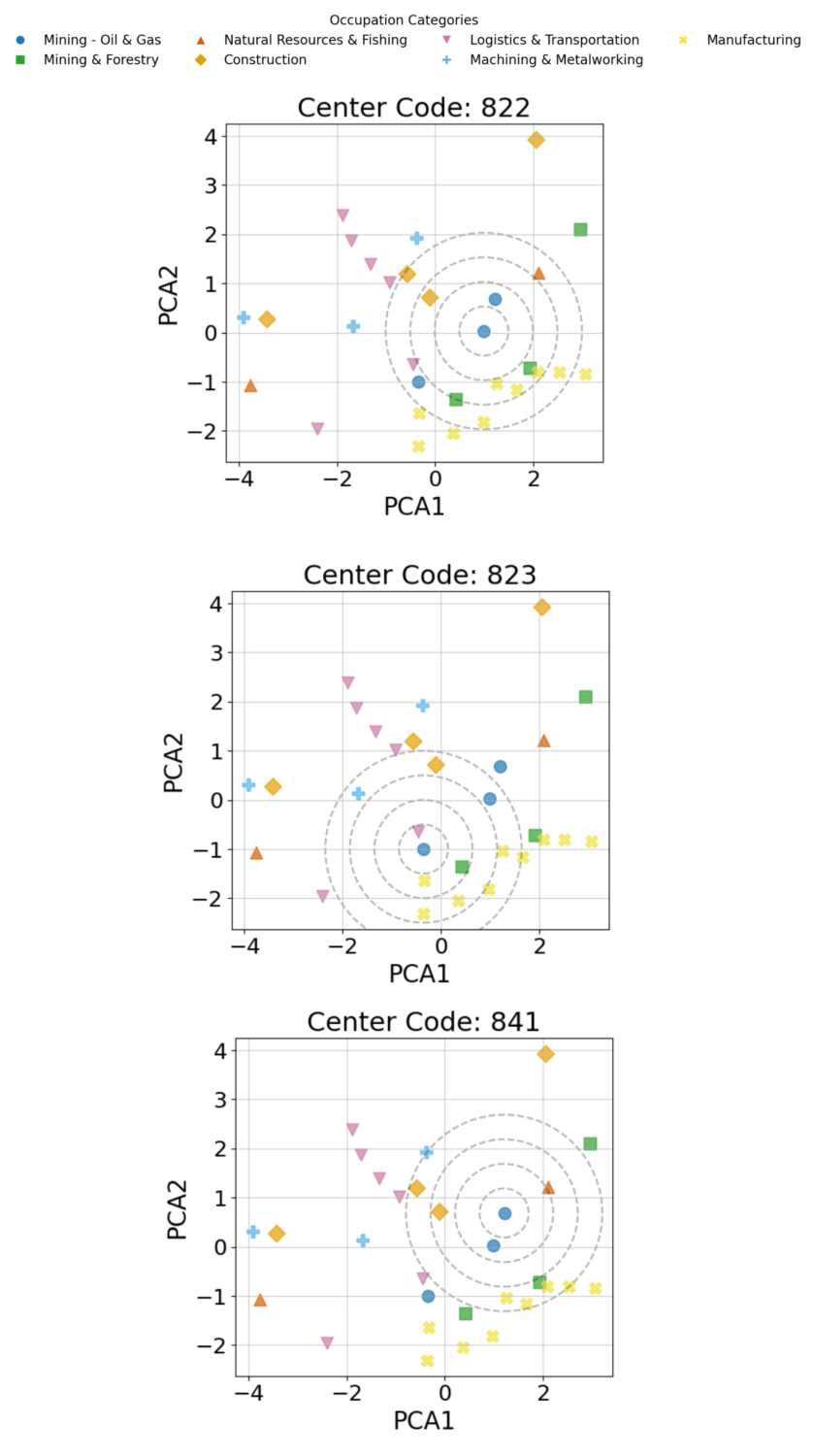
Table 1: Proximity Between Mining – Oil & Gas and Related Occupations
5. Evaluation of Current Canadian Policies
Canada’s just transition programming currently aims to facilitate the shift of jobs and industries away from fossil fuel dependency and toward low-carbon industries. Both the federal government and provincial governments, particularly Alberta, are implementing a range of support measures. Alberta, for example, has pioneered advanced initiatives for coal and oil & gas workers through direct income support, retraining programs, and relocation assistance. Meanwhile, the federal government is promoting regional economic diversification and infrastructure development through initiatives like the Canadian Coal Transition Initiative (CCTI), the Union Training & Innovation Program (UTIP), and investments in vocational training centres. Each program targets different groups and offers distinct types of support; hence, flexible approaches tailored to regional and individual needs are essential, as is effective collaboration among federal, provincial, and local levels.
Table 2: Alberta’s Key Programs, Their Target Groups, Core Offerings, and Identified Challenges
Table 3: Key Federal Programs, Their Target Groups, Core Offerings, and Identified Challenges
Summary of Key Challenges
Canada’s just transition policies, while ambitious and multi-faceted, face several significant challenges. First, regional economic differences and diverse industry structures mean that workers, particularly those with high specialization, experience uneven short- and long-term mobility. For instance, while strong local ties may suppress short-term mobility, external pressures and regional economic decline can force a rapid long-term transition. Additionally, many programs offer limited financial support or are restricted to certain worker categories, leaving gaps in income replacement and retraining. Finally, insufficient coordination among federal, provincial, and local levels, as well as unclear strategic planning at the community level, pose obstacles to the effective implementation and impact of these initiatives.
Overall, while Alberta’s pioneering efforts and the federal government’s comprehensive approach provide a strong foundation, overcoming these challenges is essential to ensure a truly just and sustainable transition for workers in high-emission industries.
6. Policy Options and Recommendations
Recommendation 1: Managing the Economic Shocks of Transition
Policies must secure workers’ income and livelihoods to minimize economic shocks and ensure stable career shifts.
Introducing Long-Term Wage Insurance
A wage insurance program could play a role in compensating workers forced to transition into lower-wage occupations due to industrial transformation. Inspired by the US Trade Adjustment Assistance (TAA) wage subsidy program, this initiative would provide compensation for up to 50 percent of the wage gap between previous and new employment for 2 to 5 years. This ensures a smooth transition while maintaining regional purchasing power. Funding sources may include carbon tax revenues and special contributions from the federal Employment Insurance (EI) program.
Expanding Pension Benefits
Strengthening pension bridging programs would support older workers’ soft landing into retirement without further continuing in high emissions industries. In Germany, coal industry retirees benefited from government-funded pension gap compensation, enabling a smooth retirement transition (Commission on Growth, Structural Change and Employment, 2019). Adoption of similar measures would help to ensure job vacancies in low-carbon industries for younger workers while providing financial security for workers retiring from high-emissions extractive industries.
Expanding Inclusive Assistance for Non-Standard and Vulnerable Workers
Current transition programs primarily cater to standard, full-time employees, leaving contract, temporary, and seasonal workers insufficiently protected, even though temporary, lower-skilled workers (e.g., NOC 841) make up over half of the workforce in these high-emissions industries. Expanding unemployment benefits and retraining subsidies to cover these workers is crucial. Additionally, targeted support should be introduced for Indigenous communities, immigrants, women, and youth, ensuring equitable access to reskilling programs and financial assistance.
Recommendation 2: Designing Low-carbon Job Transition Policy
Working with labour unions, policymakers will need to understand the needs of workers to complete sustainable industrial transformation. Establishing an integrated cross-sector training system, implementing a skills passport, and tailoring workforce training based on regional and occupational similarities should all be considered as part of a just transition package oriented to workers’ labour mobility limitations as indicated by this analysis.
Establishing an Integrated and Targeted Cross-Sector Training System
Training programs should be customized to meet regional labour market demands and align with workers’ current skill sets to ensure smooth workforce transitions. By leveraging occupational similarity analysis, retraining efforts can be optimized for high-compatibility career transitions, reducing skill mismatches and improving job placement efficiency.
Rather than limiting training to the renewable energy sector, a cross-industry training framework should be established to support transitions into manufacturing, construction, infrastructure, and digital industries. Denmark’s Flexicurity model, which balances labour market flexibility with strong vocational training, offers a potential blueprint for Canada, however this will need to be designed closesly with labour unions to ensure that workers’ needs are considered alongside employers’ needs for economic transformation. Aligning training programs with regional economic structures and occupational similarities will ensure a smoother transition for displaced workers while supporting long-term labor market stability.
Implementing a Cross-Industry Skills Passport
Building on the UK’s Energy Skills Passport, Canada should introduce a system to validate transferable skills across industries such as manufacturing, infrastructure, and technology. Such an initiative would enable workers to transition smoothly between industries without redundant training, while reducing costs and lowering barriers for employers in reskilling and upskilling their workforce.
Recommendation 3: Building a Next-Generation Employment Ecosystem
Beyond sectoral shifts, this pillar envisions an employment ecosystem that fosters sustainable job creation and economic resilience.
Strategic Tax Incentives and Investment Policies for New Industries
Investment should extend beyond renewable energy to include high-value manufacturing, and digital industries. To encourage companies to establish operations in transitioning regions, tax incentives, capital investment subsidies, and infrastructure development grants could be introduced. Canada can also draw lessons from the EU’s Just Transition Mechanism, which tailors economic support based on regional needs.
Strengthening Labour Unions and Cross-Industry Collaboration
The success of a just transition relies on strong labour representation and cross-industry cooperation. labour unions should collaborate across sectors to enhance workforce mobility needs, ensuring that workers can seamlessly shift into new employment opportunities out of high-emitting industries and into low-carbon jobs. Within Denmark’s flexicurity model, labour unions play a crucial role in administering retraining programs and supporting labour market flexibility, which has resulted in high reemployment rates through this active labour market policy. (Andersen & Torben, 2021)
Diversifying Regional Economies and Job Creation
Efforts should be made to repurpose former fossil fuel sites into industrial hubs, electric vehicle battery plants, and renewable energy facilities. Furthermore, establishing efficient and sustainable value chains between industries such as the EV industry and mining, among others, is key to ensuring growth and competitiveness, especially as US trade relations lend to disruptions in supply chains and market access. This could create synergies across industries, optimize resource utilization, and support the revitalization of regional economies while enhancing overall green transition. Canada must formulate region-specific development plans to attract investment and support long-term economic growth.
7. Discussion and Conclusion
This report examines the challenges of achieving a just transition in Canada’s high-emission sectors, highlighting the importance of labour mobility, workforce adaptation, and collaboration across industries and regions. While existing policies provide a starting point for economic diversification and worker support, they do not fully address key challenges such as wage disparities, limited labour mobility, and the need for greater investment in new industries. Through quantitative analysis, this report offers insights into career transition pathways based on labour mobility patterns and occupational similarities. However, significant gaps remain.
There are limitations to the available data on labour mobility, particularly because this study relies heavily on macro-level open data. Consequently, further quantitative and qualitative research including analyses that incorporate micro-level data is essential to refine policy solutions and bridge the gap between broad statistical trends and the complexities of on-the-ground realities. Engaging directly with workers, employers, and labour organizations will also be critical to ensuring policies reflect real-world conditions.
A just transition cannot succeed without strong partnerships with labour unions and industries. Ensuring that workers have stable, secure, and flexible career options is not just an economic necessity but a broader commitment to fairness and resilience. The approach taken here will not only shape the shift away from fossil fuels but can also serve as a blueprint for managing future transitions in other industries that may face similar structural changes.
Supporting non-standard workers, Indigenous communities, immigrants, and other vulnerable groups must also be a central focus. Without targeted policies that address their specific challenges, there is a real risk that economic and social inequalities will deepen, making it harder to achieve a transition that is fair for all.
In the coming years, policymakers will need to move forward with both urgency and careful planning, combining data-driven insights with real-world implementation. While the challenges are substantial, so are the opportunities. The choices made now will define the future of Canada’s workforce and economy. By acting decisively, Canada can set a global example—ensuring that workers are supported, communities remain strong, and the transition to a net-zero economy is both fair and lasting.
References
Atlantic Canada Opportunities Agency. (n.d.). Evaluation of the Community Capacity and Technical Infrastructure (CCTI) and CCTI Infrastructure Fund. Government of Canada. Available online.
Andersen, Torben. “The Danish flexicurity model and its adaptation to economic crises.” Danmarks Nationalbank, Economic Memo 5, August 10, 2021.
Beatty, C., & Fothergill, S. (1996). Labour market adjustment in areas of chronic industrial decline: The case of the UK coalfields. Regional Studies. https://doi.org/10.1080/00343409612331349928
Canadian Climate Institute. (2024). Canada’s oil and gas sector: The road to net zero and regional fairness. https://climateinstitute.ca/publications/canadas-oil-and-gas-sector-the-road-to-net-zero-and-regional-fairness/
Carley, S., Evans, T. P., & Konisky, D. M. (2018). Adaptation, culture, and the energy transition in American coal country. Energy Research and Social Science. https://doi.org/10.1016/j.erss.2017.10.007
Cha, J. M. (2016). Labor Leading on Climate: A Policy Platform to Address Rising Inequality and Rising Sea Levels in New York State. Pace Environmental Law Review (Vol. 34).
Commission on Growth, Structural Change and Employment. (2019). Final Report. Federal Ministry for Economic Affairs and Energy (BMWi).
Danson, M. (2005). Old industrial regions and employability. Urban Studies. https://doi.org/10.1080/0042098042000316155
Fothergill, S. (2001). The true scale of the regional problem in the UK. Regional Studies. https://doi.org/10.1080/00343400123960
Government of Alberta. (n.d.). Coal Community Transition Fund. Retrieved from https://www.alberta.ca/coal-community-transition-fund.aspx
Government of Alberta. (2019, January). Coal Workforce Transition Program: Bridge to Re-employment – Application Guidelines.
Government of Alberta. (2019, February). Coal Workforce Transition Program: Bridge to Retirement – Application Guidelines.
Government of Alberta. (2019, January). Coal Workforce Transition Program: Relocation Assistance – Application Guidelines.
Government of Alberta. (2019, February). Coal Workforce Transition Program: Tuition Voucher – Application Guidelines.
Healy, N., & Barry, J. (2017). Politicizing energy justice and energy system transitions: Fossil fuel divestment and a “just transition.” Energy Policy. https://doi.org/10.1016/j.enpol.2017.06.014
Lim, J., Aklin, M., & Frank, M. R. (2023). Location is a major barrier for transferring US fossil fuel employment to green jobs. Nature Communications, 14, 5711.
Natural Resources Canada. (2024). Sustainable Jobs and Economic Development: A Report on Canada’s Transition. Government of Canada.
Newell, P., & Mulvaney, D. (2013). The political economy of the “just transition.” Geographical Journal. https://doi.org/10.1111/geoj.12008
Mertins‐Kirkwood, H., & Duncalfe, C. (2021). Roadmap to a Canadian just transition act: A path to a clean and inclusive economy. Canadian Centre for Policy Alternatives.
Minchin,T.J. (2009). ‘It knocked this city to its knees’: the closure of Pillowtex Mills in Kannapolis, North Carolina and the decline of the US textile industry.’ Labor History, 50(3), 287-311.
Xie, J. J., Martin, M., Rogelj, J., & Staffell, I. (2023). Distributional labour challenges and opportunities for decarbonizing the US power system. Nature Climate Change, 13, 1203–1212. https://doi.org/10.1038/s41558-023-01842-1
Zaussinger, F., Schmidt, T. S., & Egli, F. (2025). Skills-based and regionally explicit labor market exposure to the low-carbon transition in Europe. Joule.
Download the full report for appendices containing data sources, target industries and further details regarding PCA analysis.
